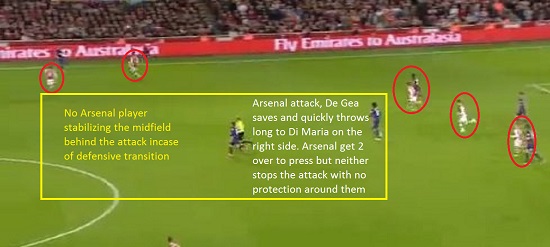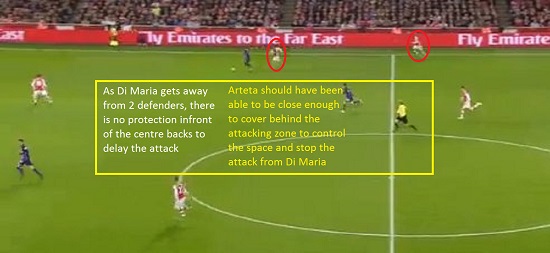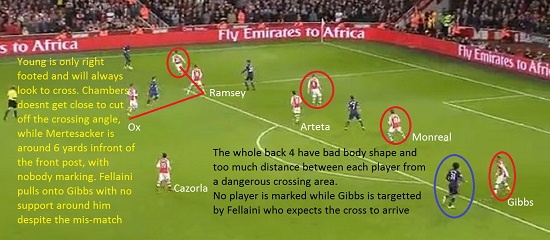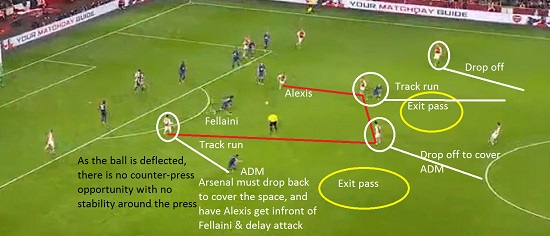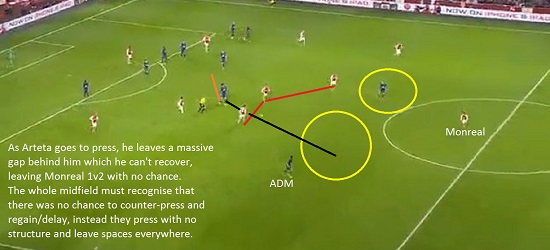By Stevie Grieve
In the last few seasons, Arsenal have tried to play a possession and pressing system, but often with massive instability, mainly through Mikel Arteta’s bad decision making at the bottom of the midfield triangle when deciding to press (and often foul) or drop off.
As he was always more of a controlling central midfielder than a deep playmaker in the #6 position, adjusting to this position in an attacking sense has been a lot easier than the defensive aspects needed for the role, such as pressing, covering, screening passes into strikers, tracking runners and offering protection to centre backs.
In the recent game against Manchester United, the lack of stability in the Arsenal midfield out of possession was again evident, particularly when pressing, and often with no stability around or behind the pressing zone.
Example; Rooney’s goal for 2-0 in the 86th minute
In this image, the ball is rebounded to the central midfielder. Above the dotted line, there is only 1 player able to confront the ball carrier and delay play, and not from a weak side position. This dictates that the press is not possible and the deepest players in the vicinity should simply retreat into deep positions and not allow the ball into the gaps behind the players in the pressing vicinity.
Ideally, the team in defensive transition (black) will drop off and track the runners, and get as many people into a defensive shape 40m-30m from goal then become organised.
Instead, Arsenal presses with no stability behind the press. If there was an opportunity to press, there would be 2 covering players along the dotted red line, covering the exit routes away from pressure. As there are no players covering, the pass behind the press results in a 2v1.
This has been a common feature for the best part of 3 seasons and until Arsenal can become co-ordinated in the pressing actions, they will not get anywhere near winning the Premier League or Champions League.
Positioning Behind the Ball in Attacking Phases
When attacking a low block, there needs to be small distances to retain possession and provoke the defence to come out and press to leave space. This also applied to when the ball is lost, particularly against a team with fast players on the sides, players like Angel Di Maria.
Here, Arsenal lose the ball and have 4 players forward, both full backs high and wide, and no cover in central midfield. As the ball is thrown wide, Arsenal have no protection in central midfield, Di Maria is in the space of the advanced full back so as the long throw is made, Gibbs cannot recover and Arteta is well out of position. As Di Maria receives, he can dribble 1v1 or pass inside and have a clear run through the centre at Arsenal’s exposed centre backs – neither of whom are comfortable with a high line.
In the offensive phase, Arteta should be covering behind the ball and be able to anticipate when he wil be needed 2 passes ahead of time, and be able to see where the danger will come from if the ball is lost. He doesn’t, and as a result Manchester United have a clear counter attack.
No Marking or prioritization of danger when dealing with wide attacks
Arsenal know that Ashley Young is only going to cut back and cross, and will likely look for Fellaini. As no Arsenal player has the correct body shape to see the movements of each attacker or each other, they have no idea that Gibbs is left with Fellaini and no help around him.
Arteta’s position is between the CB’s who are too far apart; Mertesacker is worried about the reverse pass to Van Persie and wants to get over and press – this should be Ramseys job – while neither Arteta or Monreal mark Di Maria. Monreal really needs to be closer to Gibbs, so Arteta should take Di Maria while Ox can cover the edge of the box with Cazorla. As this happens, the cross to the back post is made, Szczesny comes out to attack the ball and can only make a small punch, Valencia arrives untracked and blasts the ball across goal which Gibbs turns in. This would often be regarded as ‘unlucky’ but this is the sort of soft goal Arsenal lose regularly through a lack of defensive positioning and organisation between players.
[wpsharely id="3095"][/wpsharely]Pressing when unstable around the pressing zone
[wpsharely id="2988"][/wpsharely]
As the image at the top shows, there is no way that an effective counter-press can be made here, with 2 clear exit routes for Fellaini. As Fellaini regains the ball, he can wait to see the defensive action of each Arsenal player before choosing his pass.
- If they all press; he will release behind short and to feet, an easy pass.
- If they drop off; he has a more difficult ball over the top which may have more pressure when receiving on the side and with cover inside from Arsenal.
Arsenal press with no stability around or behind the press, leaving themselves open to a 2v1.
Overall, Mikel Arteta may have a high pass completion rate but his decision making when to press or to drop off is a large reason why Arsenal have looked so poor out of possession for a long time, and until the tactical system is adapted to protect the defence better, Arsenal will struggle in big games.
By Stevie Grieve. (Follow on Twitter @steviegrieve) Stevie is also the author Coaching the 4-2-3-1, Coaching the 4-2-3-1 Advanced Tactics and From Futsal to Soccer



